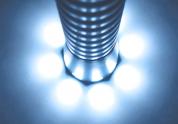Many manufacturers and suppliers of LED lamps make great lamps that are safe to use. If they didn’t, they would not be in business for too long. While some manufacturers and suppliers have been prone to overstate performance, they too are being weeded out as the market becomes increasingly savvy about their inflated performance claims. However, there are tested and compliant lamps when used in particular applications will render the lighting installation to be unsafe.
Here are two examples of unsafe practises using safe lamps:
- Fitting a different sized LED lamp to the original lamp it is replacing even though it has the same base type. Just because the manufacturer states their LED lamp is an MR-16 it does not mean it has the same physical characteristics as an old Tungsten Halogen MR-16 lamp. A problem occurring in the field is where an existing lamp holder has been altered or ‘hacked’ for the LED replacement lamp to fit. This practice is careless, unsafe and can lead to major hazards.
- Using a direct replacement LED lamp in an enclosed luminaire can dangerously compromise the heat management of the lamp leading to a potential fire hazard. Though the lamp itself is tested, compliant and safe to use, the application creates a danger.
- Additional caution notes for selecting LED Lamps and using them safely and effectively:
- Does the lamp comply with the relevant standards? Does it comply with stafety standards? And are there electrical approval/saftey markings? Chances are if it doesn’t its clearly not safe and there are other areas the manufacturer has cut corner that will compromise safety.
- Confirm the size and weight of the LED replacement lamp against the lamp being replaced. The best LED replacement solution will deliver electrical and physical compatibility. Other size lamps can cause problems in some way.
- Avoid purchasing unbelievably cheap lamps, especially lamps without compliance certification or compliance markings. eBay and other non-certified sellers are known to have sold non-compliant products that expose users to live mains power. It can be difficult to pin the seller down should there be a problem, especially if the seller is based in another country.
- Confirm the ambient temperature that the LED light source will operate within is suitable. Failure to do so may have an adverse effect on performance and safety.
- Ensure the existing socket attachment position for downlights is a match to the light distribution of the replacement LED lamp. Failure to check the downlight position may result in the light beam being cut-off in the fixture and therefore not producing the required illumination level.
- When installing an LED lamp in a luminaire with a dimmer or a closed cover check the compatibility of the particular LED lamp.
Download EYE Lighting’s guide to for LED direct replacement lamps for more details – All the KnowLEDge You Need (What you should know before installing LED Lighting).
If you are still unsure, contact a lighting professional.
